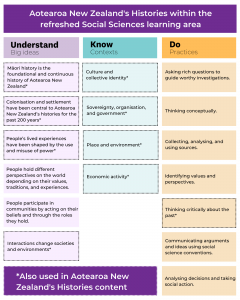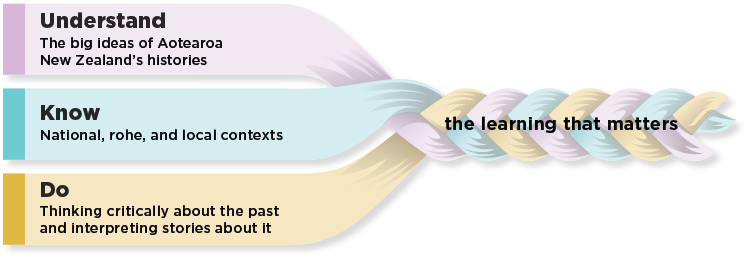The curriculum taught in New Zealand schools is currently undergoing a refresh and changes to the eight curriculum learning areas will be phased in over the next three years (2023-2026). The first area to be redesigned and introduced into schools across the country is the Aotearoa New Zealand Histories Curriculum. This forms the cornerstone of the Social Sciences learning area and is designed to provide students with a comprehensive understanding of the history of New Zealand, from the arrival of the first Māori settlers to the diversity of modern-day New Zealand.
The Aotearoa New Zealand Histories Curriculum is an important step towards developing a more inclusive and balanced approach to teaching New Zealand history. Our students must have a thorough awareness of the events and experiences that formed our nation. The new curriculum progressions seek to enhance awareness of New Zealanders’ different cultures, experiences, and viewpoints, as well as to give students the knowledge and skills to become engaged and educated citizens.
Is the new curriculum compulsory?
Yes, the Aotearoa New Zealand Histories Curriculum is required in all New Zealand primary and secondary schools. It will be implemented in schools in 2023, as part of the first phase of the curriculum renewal. The new curriculum intends to teach New Zealand history in a fair and inclusive manner. It aims to dispel some of the myths surrounding New Zealand’s history, such as the myth of peaceful settlement and the assumption that Mãori were passive recipients of European culture and technology.
It is critical that our students have a thorough awareness of the events and experiences that have built our country, as well as the information and skills necessary to become engaged and informed citizens. We invite you to help your children learn by discussing the curriculum with them and being involved in their studies. We can assist our children gain a better understanding of our shared past by working together to establish a stronger, more inclusive society for future generations.
How does it link to the Social Science curriculum area?
The Social Sciences learning area covers a range of subjects, including history, geography, economics, and civics and citizenship. The Aotearoa New Zealand Histories Curriculum will be taught as part of the history component of the Social Sciences learning area.
Aotearoa New Zealand’s Histories is an ambitious and comprehensive makeover built on three aspects – Understand, Know, and Do – that are taught concurrently and intertwined across years one to thirteen. It was created in collaboration with academics, teachers, historians, the New Zealand Council for Educational Research, and the Royal Society Te Apārangi as part of a five-year curriculum revamp.
What is ‘new’ in the new curriculum?
The refreshed curriculum is intended to be cumulative, with five stages of learning progressions replacing the year-level objectives. The progression model replaces year-level achievement objectives with five phases of learning (Y1-3, Y4-6, Y7-8, Y9-10, Y11-13). It is designed to be cumulative and progressively complex. These stages of learning serve as guideposts along the learning process, designed to make it easier for teachers to create rich and responsive learning, and it puts ākonga – their voice, well-being, and aspirations, at the centre of curriculum design. Each phase of learning has progress outcomes that specify what ākonga should understand, know, and do at that stage. Each of these parts has a distinct but complementary focus. Students get a deeper comprehension of the key concepts (understand) when they investigate the context (know) via critical practises (do).

In general, the “understand” component of the new Social Sciences curriculum explains the overall picture through these important concepts:
- Māori history is the foundational and continuous history of Aotearoa New Zealand.
- Colonisation and settlement have been central to Aotearoa New Zealand’s histories for the past 200 years.
- People’s lived experiences have been shaped by the use and misuse of power.
- People hold different perspectives on the world depending on their values, traditions, and experiences.
- People participate in communities by acting on their beliefs and through the roles they hold.
- Interactions change societies and environments.
The “know” component investigates these concepts through the lenses of:
- Culture and collective identity | Ngā ahurea me te tuakiri kiritōpū
- Sovereignty, organisation, and government | Te tino rangatiratanga me te kāwanatanga
- Place and environment | Te tūrangawaewae me te taiao
- Economic activity | Ngā mahinga ohaoha
And the “do” component of the curriculum is a “how to study history” set of practices:
- Asking rich questions to guide worthy investigations
- Thinking conceptually
- Collecting, analysing, and using sources
- Identifying values and perspectives
- Thinking critically about the past
- Communicating arguments and ideas using social science conventions
- Analysing decisions and taking social action
Further information, including the feedback from the Ministry consultation process, can be found here: https://curriculumrefresh.education.govt.nz/social-sciences

Recent Comments